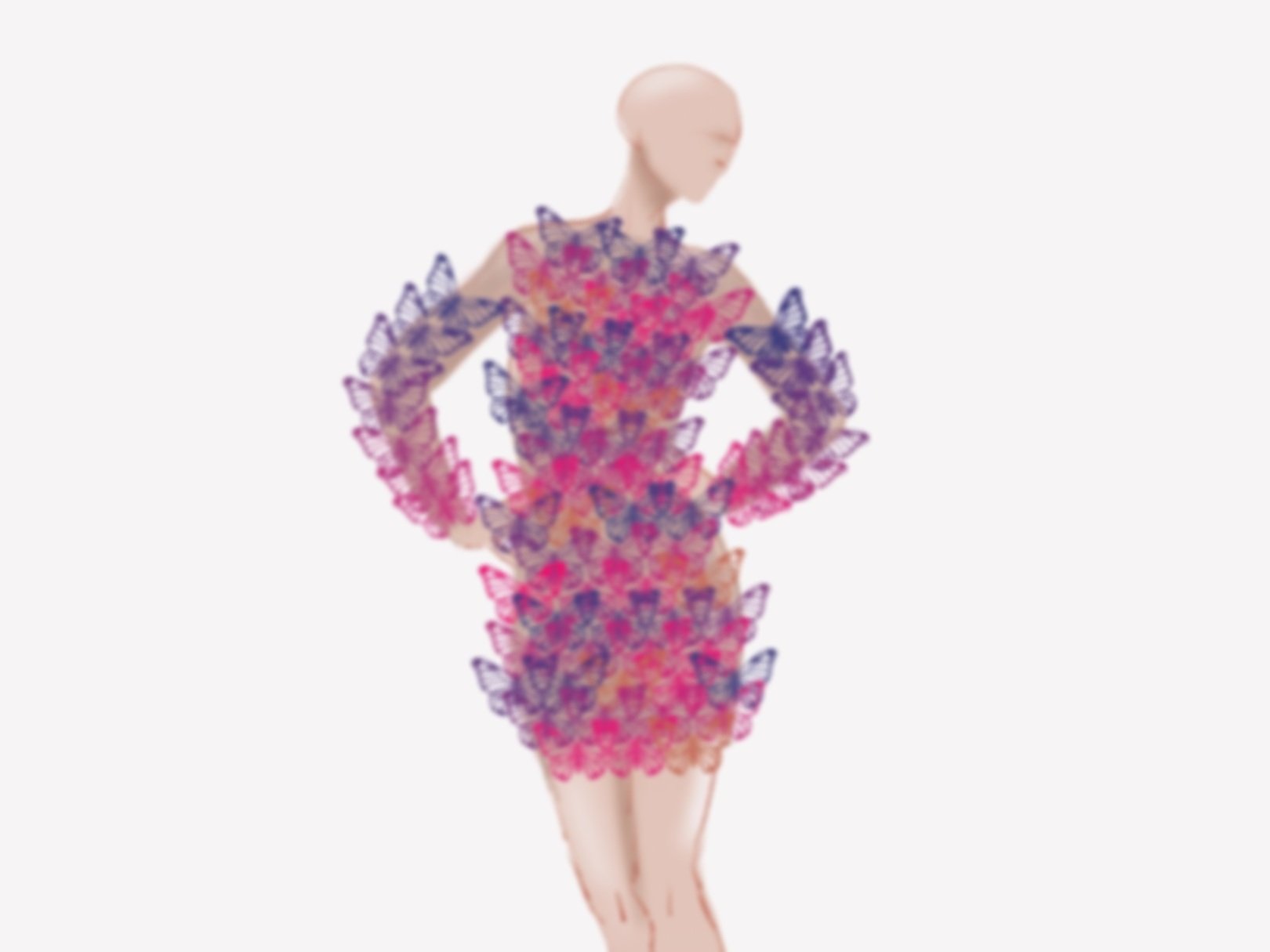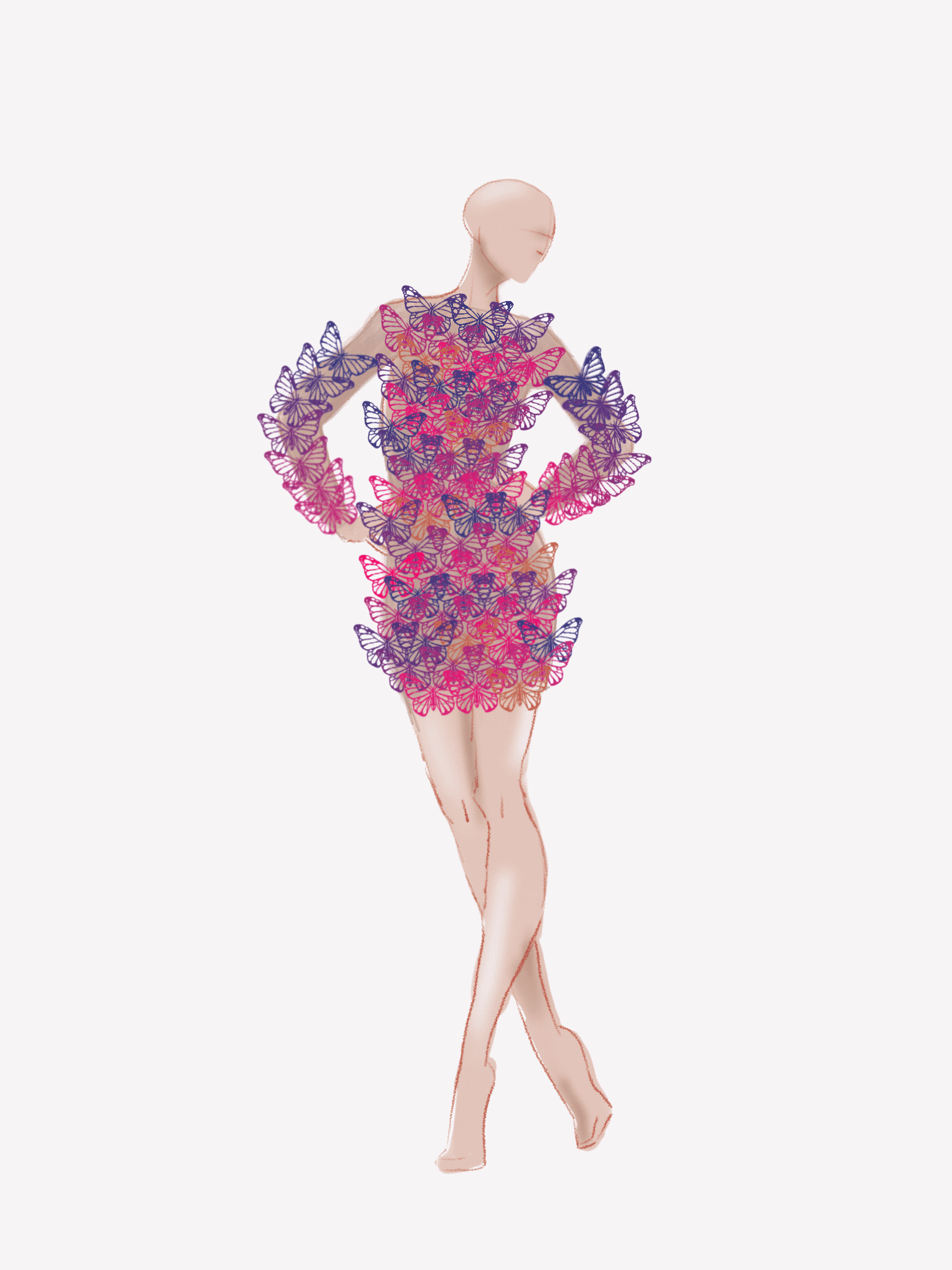
Chrysalis
Soft Robotics | Responsive Garments
2023
A dynamic wearable utilizing soft robotics, supported by Backslash at Cornell Tech.
The idea for this project was born on a chilly winter day in the subway. Bundled in layers, the inability to adjust clothing for comfort struck a chord—what if clothing could adapt dynamically to the wearer’s needs? Soft robotic butterflies became the focus, envisioned as flexible and lightweight structures capable of opening their wings to provide warmth and closing them to cool the body. This fusion of fashion and robotics aimed to explore the potential of wearable, responsive garments.

The butterfly has long been a symbol of transformation, elegance, and adaptability. Inspired by its delicate wings, Chrysalis is a dynamic wearable that reimagines how fashion can respond to the needs of its wearer. The design draws from the lightweight, flexible nature of butterfly wings, integrating silicone-based soft robotic structures capable of expanding and contracting in a graceful, organic motion. These movements mimic the natural opening and closing of butterfly wings, offering both visual beauty and functionality.
The project began with the vision of creating a garment that could adapt dynamically to changing environments, much like a butterfly adjusting to its surroundings. By leveraging the principles of soft robotics, Chrysalis demonstrates how technology and nature can intersect, resulting in a wearable that not only captivates visually but also functions as a responsive, adaptive piece of art. This exploration of movement, form, and interaction showcases the potential for fashion to evolve into a truly transformative experience, blurring the lines between engineering, design, and self-expression.
This project tackles several complex technical challenges in the pursuit of integrating soft robotics into wearable design. The first challenge involved the creation of lightweight, flexible structures that mimic the organic motion of butterfly wings. Silicone-based components were designed and cast using custom molds to achieve the delicate expansion and contraction needed for the garment. The process required extensive experimentation with materials and fabrication techniques to balance durability, flexibility, and aesthetic appeal. The second challenge centered on delivering air to these soft robotic elements. This required over 50 pumps to operate each individual butterfly, making the system impractical for portability or wearability.
The silicone butterfly structures were successfully developed through extensive CAD modeling, mold fabrication, and casting, resulting in lightweight, flexible components capable of mimicking the graceful expansion and contraction of butterfly wings. However, the issue of air delivery posed a significant hurdle. Each butterfly required its own tube and sufficient air pressure. This complexity rendered the design impractical, especially given the lack of a wearable air compressor capable of powering such a system. The absence of a compact and portable solution for air delivery made it clear that while the butterfly concept was feasible in isolation, it was not wearable in its current form. This limitation led to a reevaluation of the project, highlighting the challenges of scaling soft robotic designs for functional and portable applications.
The project began with extensive experimentation in soft robotics to create the envisioned dynamic butterfly wings. Using CAD software, multiple shapes were designed to explore flexible and lightweight forms that could open and close easily. These designs were then 3D printed into physical molds, which served as the foundation for silicone casting. Silicone was chosen for its flexibility and lightweight properties, making it ideal for wearable, responsive components. The cast wings were tested extensively, successfully expanding and contracting as intended, proving the feasibility of the concept.
THE PROCESS
Modeling in Fusio360
3D printing molds
Silicon casting
THE BUTTERFLIES
3D printed butterfly attached to silicone actuator
Pure silicone butterfly actuator
Realizing the limitations of the butterfly concept, the project pivoted to Respira. Instead of individual pumps for each element, the dress was engineered to use just two air pumps to create a dynamic, "breathing" effect. This maintained the goal of integrating soft robotics into fashion.
Respira mimics the expansion and contraction of living organisms, blending art, engineering, and wearability. This transformation from butterflies to a single, cohesive breathing design highlights the importance of adaptability in problem-solving and creativity.
This project represents a significant step in integrating soft robotics into wearable technology. From flexible, responsive designs to streamlined systems, it explores how fashion can become more interactive and functional. It serves as a foundation for future work in adaptable clothing and demonstrates the potential of soft robotics to revolutionize wearable technology.
At its core, Chrysalis explores the potential of wearables to merge self-expression, innovation, and adaptability. By drawing inspiration from the natural beauty and transformative power of butterflies, this project demonstrates how bio-inspired soft robotics can enhance the sensory and interactive experience of fashion. It envisions a future where garments not only captivate visually but also respond dynamically to the wearer and their environment.
Credits
Director of MakerLAB @ Cornell Tech
Lab Manager
Niti Parikh
Sebastian Bidegain

